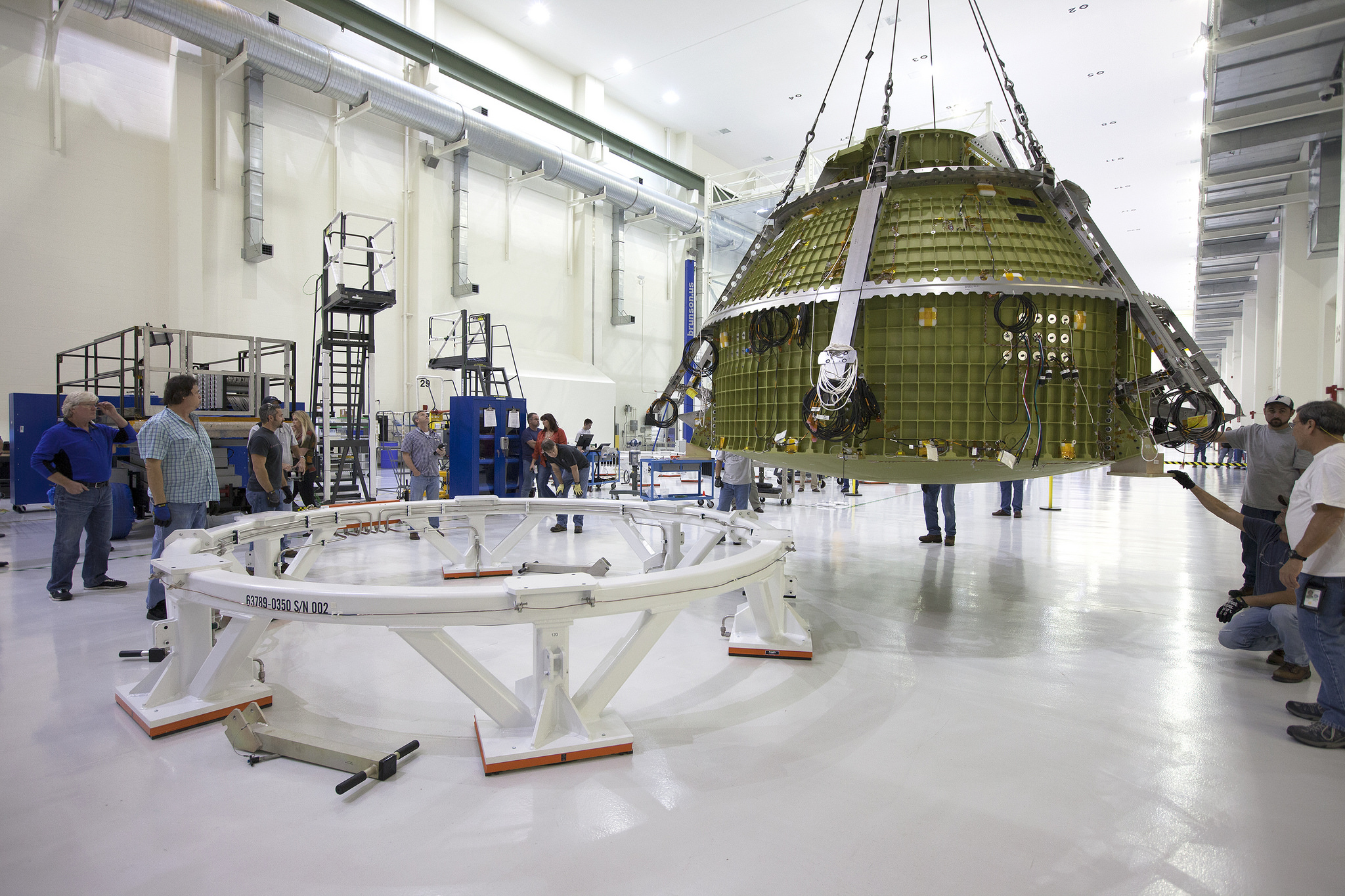
NASA’s first SLS Orion crew capsule has successfully passed a series of proof-pressure tests carried out by engineers with Lockheed Martin at the space agency’s Kennedy Space Center (KSC) launch site in Florida.
The capsule, which is destined to travel farther than any crew-rated vehicle in history on the inaugural launch of the Space Launch System (SLS) on Exploration Mission-1 (EM-1) in late 2018, currently sits in the Neil Armstrong Operations and Checkout Building. The completed underlying structure, or pressure vessel, provides a sealed environment for astronaut life support, and is the backbone for major systems such as propulsion, avionics and parachutes.
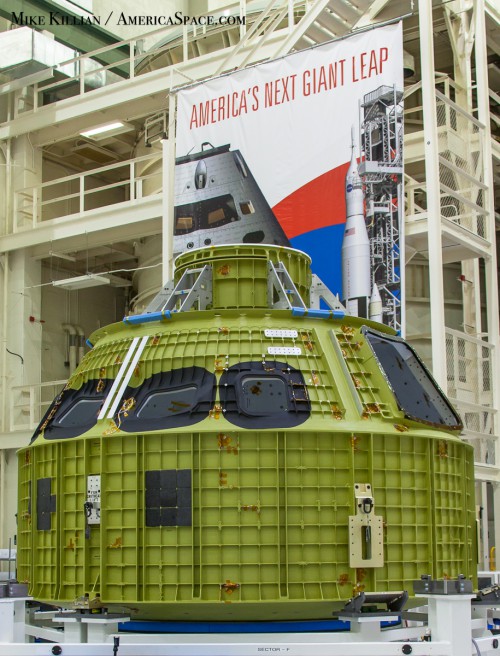
The vehicle arrived at KSC Feb. 1 onboard NASA’s Super Guppy transport plane from Michoud Assembly Facility in New Orleans, La., at which time work immediately began where it left off at Michoud.
For the test series technicians moved Orion into a “proof pressure cell” and attached approximately 850 instrument strain gauges on the vehicle’s exterior and interior, providing real time data to engineers monitoring changes in pressure. The tests were carried out in incremental steps over two days time to reach 1.25 times the maximum pressure Orion and its crews are expected to experience over the course of their missions.
“About 20 pounds per square inch of pressure was distributed over the entire inner surface of the spacecraft trying to burst it from within,” noted Lockheed Martin, Orion’s prime contractor, in a statement May 11.
The tests confirmed that the weld points of Orion’s EM-1 skeleton WILL work as expected, keeping a crew alive and handling the loads it will face during launch, cruise, and re-entry phases of the mission.
Seven large aluminum pieces make up Orion’s pressure vessel, which required 15 total welds using a state-of-the-art process called friction-stir welding to produce very strong bonds by transforming metals from a solid into a plastic-like state, and then using a rotating pin tool to soften, stir and forge a bond between two metal components to form a uniform welded joint.
With the milestone proof-pressure tests now complete Orion will be moved back onto a “birdcage” test stand in the clean room for installation of its secondary structures such as tubes, tanks and thrusters, once a final inspection using “phased array technology” to ensure there are no defects in the welds are completed.
Once Orion’s secondary structures are in place, the propulsion and environmental control and life support systems will be installed.
“Our experience building and flying Exploration Flight Test-1 has allowed us to improve the build and test process for the EM-1 crew module,” said Mike Hawes, Lockheed Martin Orion vice president and program manager. “Across the program we are establishing efficiencies that will decrease the production time and cost of future Orion spacecraft.”
Upcoming tests will include a launch simulation and power-on, as well as acoustics and vibration testing at NASA’s Plum Brook Station in Sandusky, Ohio.
Development of the first SLS rocket, meanwhile, continues to move forward too. It’s solid rocket booster will undergo one more test fire in June, and Aerojet Rocketdyne is carrying out test fires of its RS-25 engines at Stennis Space Center. Michoud has already built the first pieces of flight hardware for the rocket as well, and continues constructing the massive rocket’s core stage using the world’s largest spacecraft welding tool.
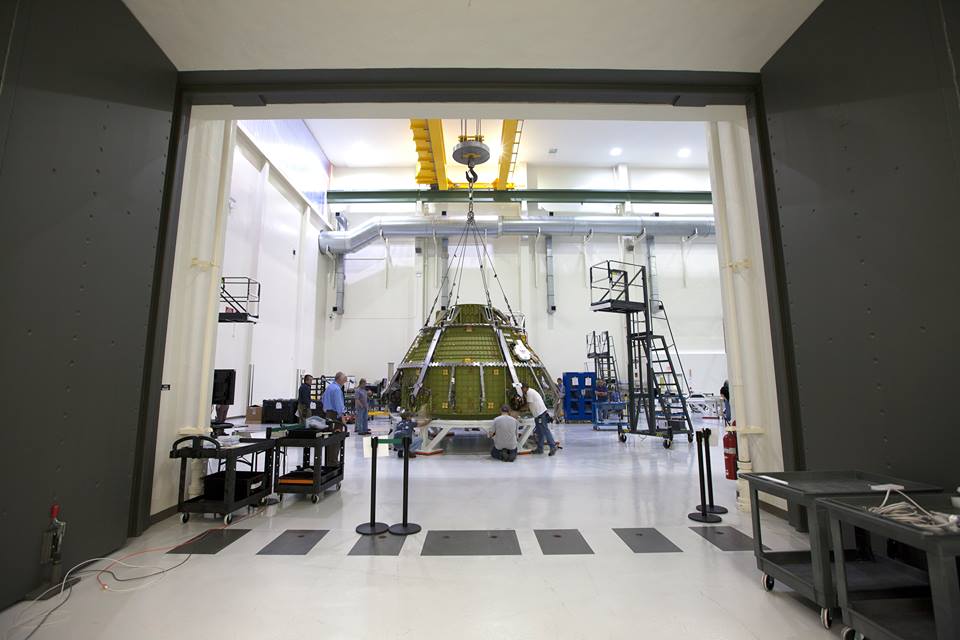
In addition, infrastructure at KSC continues to prepare for SLS too, with work inside the iconic Vehicle Assembly Building (VAB) currently underway installing work platforms in the SLS high bay to support integrating SLS & Orion together for rollout to nearby launch pad 39B.
However, the overall direction for SLS remains unclear, with more support for moon missions before Mars being voiced more and more, most recently by legendary astronaut Jim Lovell in an interview with AmericaSpace earlier this month, who flew to the moon twice on Apollo 8 and Apollo 13.
NASA hopes to launch SLS / Orion EM-1 as soon as fall 2018 on its uncrewed verification flight test to the moon and back, with the first crewed flight coming sometime between 2021 and 2023.
.
Be sure to “Like” AmericaSpace on Facebook and follow us on Twitter: @AmericaSpace
.
Missions » SLS » EM-1 »



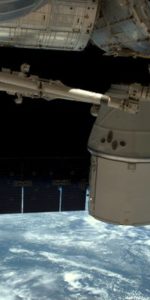
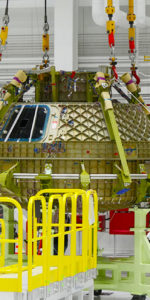
It sure is going to be good to see a spacecraft return to lunar orbit, to be followed within a couple of years by a crew seeing something no persona has since Apollo 17, the Moon, up close.
Agreed.
Lets hope politics does not screw it up.
Agreed, too. And this time I won’t be a kid seeing a fuzzy image on a black & white television. I plan on seeing the monster SLS/Orion launch in person. I’m with Joe on the politicians not screwing things up.
Yep! I agree. I hope to see “the monster SLS/Orion launch in person. I’m with Joe on the politicians not screwing things up.”
Have a great week everyone!